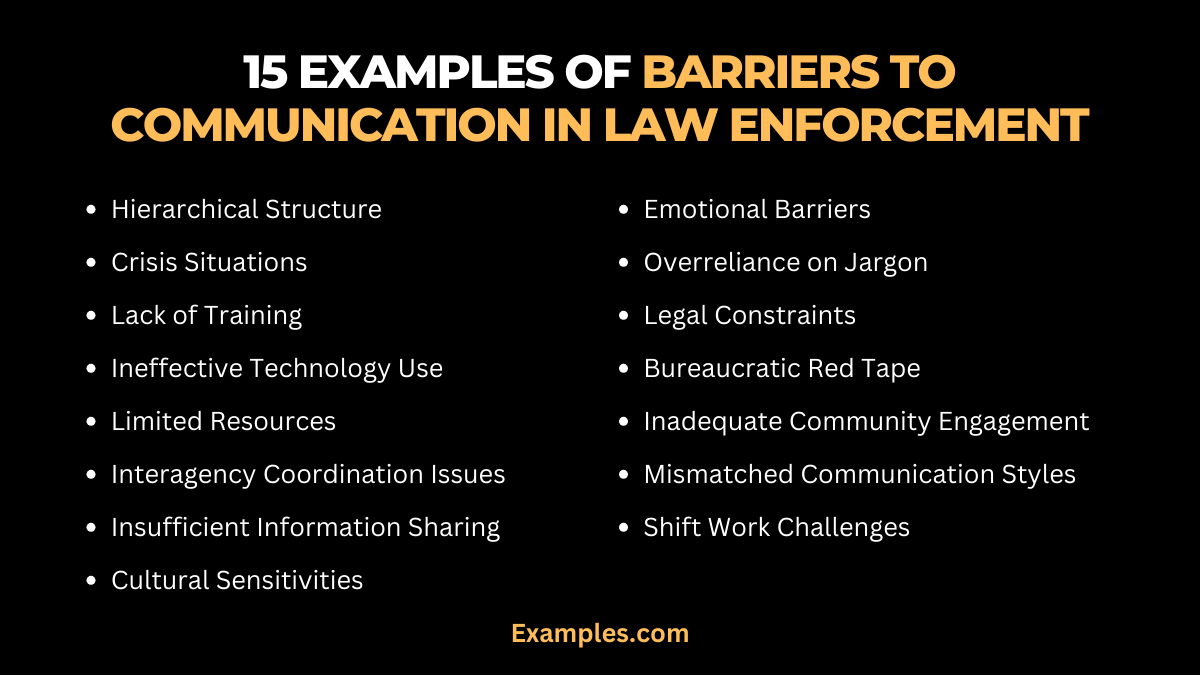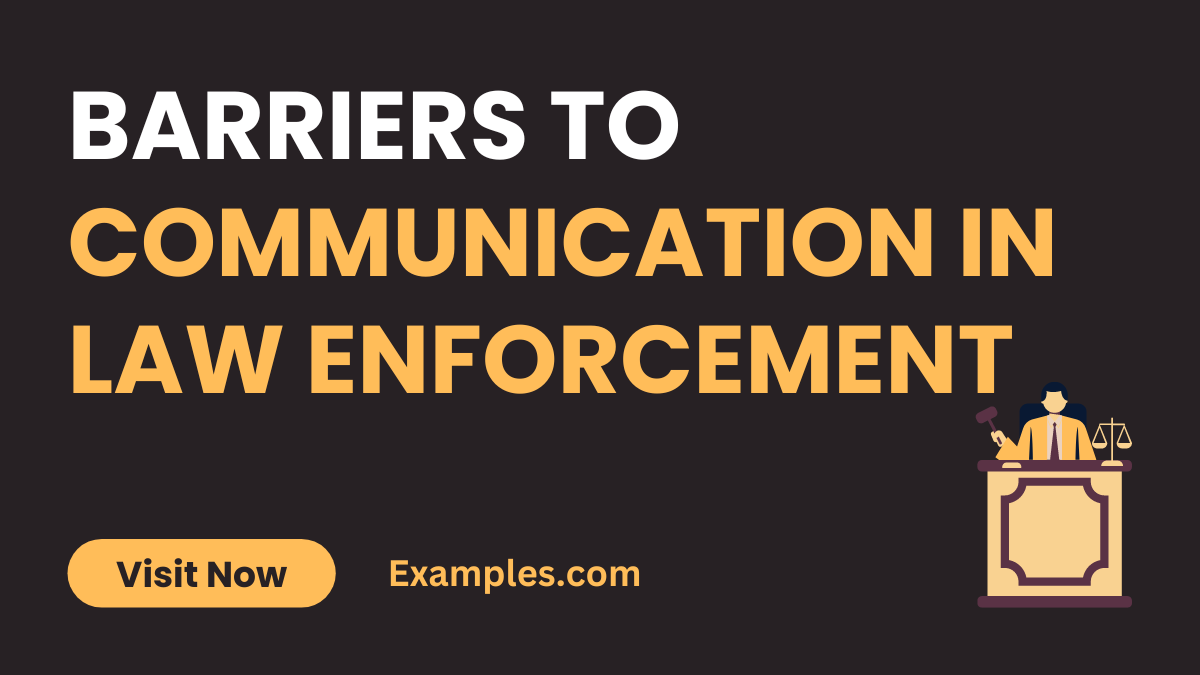14+ Barriers to Communication in Law Enforcement Examples
In the realm of law enforcement, effective communication is pivotal, yet barriers can impede this crucial process. This comprehensive guide dives into the intricacies of communication within the field, providing insights into barriers at federal and departmental levels. Uncover real-world examples that shed light on these obstacles, empowering law enforcement professionals with strategies to navigate and dismantle communication challenges. Strengthening communication bridges is essential for fostering trust, safety, and effective policing.
What are the Barriers to Communication in Law Enforcement
In straightforward terms, barriers to communication in law enforcement refer to obstacles that hinder the clear exchange of information within the field. These hurdles can manifest as issues at the federal level or within police departments, impeding effective collaboration and information dissemination. Recognizing and addressing these barriers is crucial for enhancing communication efficacy among law enforcement professionals, promoting transparency, and ultimately contributing to safer and more effective policing.
15 Examples of Barriers to Communication in Law Enforcement
Delve into the complexities of law enforcement communication barriers, understanding the impediments and strategizing for effective policing.

- Hierarchical Structure: Break down rank-related barriers by fostering open communication channels within the department.
- Crisis Situations: In high-stress situations, clear communication is crucial; practice concise and precise messaging for swift response.
- Lack of Training: Combat this barrier with comprehensive communication training programs for all law enforcement personnel.
- Ineffective Technology Use: Optimize technology adoption for seamless communication, reducing delays and misunderstandings.
- Limited Resources: Even with limited resources, prioritize effective communication strategies for optimal outcomes.
- Interagency Coordination Issues: Enhance collaboration by improving communication protocols between different law enforcement agencies.
- Insufficient Information Sharing: Promote a culture of information sharing to bridge gaps in intelligence and improve overall safety.
- Cultural Sensitivities: Address cultural nuances within the force to minimize misunderstandings and enhance intercultural communication.
- Emotional Barriers: Encourage open dialogue to address emotional barriers and foster a supportive work environment.
- Overreliance on Jargon: Mitigate communication challenges by minimizing the use of complex jargon, ensuring clarity for all team members.
- Legal Constraints: Navigate legal constraints with precise communication strategies to stay within legal boundaries.
- Bureaucratic Red Tape: Streamline communication processes, minimizing bureaucratic hurdles for swift decision-making.
- Inadequate Community Engagement: Enhance community relations through proactive communication, building trust and cooperation.
- Mismatched Communication Styles: Recognize and adapt to different communication styles within the force for harmonious interactions.
- Shift Work Challenges: Overcome communication gaps caused by shifts with robust handover procedures and digital communication tools.
Barriers to Communication in Law Enforcement at Federal Level
Explore the intricate challenges that hinder effective communication within federal law enforcement agencies. This section uncovers unique barriers at the federal level, providing insights into overcoming obstacles and fostering seamless collaboration.
- Interagency Jurisdictional Conflicts: Coordinate jurisdictional efforts to streamline communication and enhance joint operations.
- Security Clearance Protocols: Develop streamlined processes to ensure efficient communication despite stringent security clearance requirements.
- National Security Prioritization: Balance national security priorities with local concerns through transparent and inclusive communication.
- Diverse Agency Cultures: Facilitate cross-agency communication by promoting cultural understanding and shared goals.
- Information Silos: Implement centralized databases to break down information silos, fostering comprehensive and real-time communication.
Barriers to Communication in Law Enforcement for Police Departments
Within police departments, unique challenges may arise. This section explores barriers specific to local policing, offering practical solutions to enhance communication effectiveness.
- Community Trust Deficits: Rebuild trust through community engagement programs, ensuring transparent and empathetic communication.
- Limited Community Input: Establish forums for community members to express concerns, promoting two-way communication.
- Budgetary Constraints: Overcome financial barriers by prioritizing cost-effective communication tools and training programs.
- Officer Accountability: Promote accountability through clear communication channels for reporting and addressing concerns.
- Inadequate Officer Training: Invest in ongoing training to address communication gaps and enhance officers’ interpersonal skills.
What is Communication in Law Enforcement
Communication in law enforcement is a multifaceted and critical aspect of policing. This comprehensive guide explores the fundamental dynamics of communication within the law enforcement context, emphasizing its significance in fostering effective collaboration, community trust, and successful policing strategies.
- Defining Law Enforcement Communication: Unpack the various dimensions of communication within law enforcement, encompassing verbal and non-verbal cues, technology integration, and the unique challenges faced by officers in diverse situations.
- Importance of Clear Communication: Examine how clear and concise communication is pivotal in ensuring officer safety, preventing misunderstandings, and promoting efficient decision-making in high-stakes scenarios.
- Community Engagement through Communication: Explore how communication serves as a bridge between law enforcement agencies and the community, fostering transparency, trust, and cooperative efforts for safer neighbourhoods.
- Navigating Crisis Communication: Delve into the specialized communication strategies employed during crisis situations, emphasizing the importance of timely and accurate information dissemination to manage and mitigate emergencies.
- Training for Effective Communication: Understand the role of training programs in equipping law enforcement professionals with the necessary communication skills, emphasizing de-escalation techniques, conflict resolution, and cultural competence.
- Technology Integration and Law Enforcement Communication: Explore the impact of technology on modern law enforcement communication, from radio systems to digital platforms, analysing both advantages and challenges in the digital age.
In conclusion, this comprehensive guide has illuminated the intricate landscape of communication barriers in law enforcement, providing actionable strategies and real-world examples. By acknowledging, understanding, and addressing these hurdles, law enforcement professionals can forge stronger connections, foster community trust, and ultimately enhance the effectiveness of policing efforts for a safer and more cohesive society.




